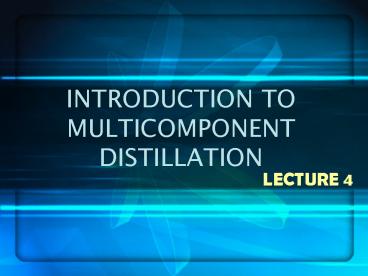INTRODUCTION TO MULTICOMPONENT DISTILLATION - PowerPoint PPT Presentation
1 / 28
Title:
INTRODUCTION TO MULTICOMPONENT DISTILLATION
Description:
Principle same as binary distillation. Mass balance ... distillation, only 1 column ... It is the ratio of mole fraction in vapor and liquid phase in ... – PowerPoint PPT presentation
Number of Views:1327
Avg rating:3.0/5.0
Title: INTRODUCTION TO MULTICOMPONENT DISTILLATION
1
INTRODUCTION TO MULTICOMPONENT DISTILLATION
- LECTURE 4
2
OVERVIEW
- INTRODUCTION
- PHASE EQUILIBRIUM
- FLASH DISTILLATION OF MULTICOMPONENT MIXTURES
- FRACTIONATION OF MULTICOMPONENT MIXTURES
3
INTRODUCTION
- In industry, distillation processes involve the
separation of more than 2 components - Principle same as binary distillation
- Mass balance for each components
- Equilibrium data is used to calculate boiling
points and dew points
4
INTRODUCTION
- In binary distillation, only 1 column is needed
- Multicomponent of n mixtures, n-1 column is
required - Phase equilibria for multicomponent more complex
because of the several components - Equilibria depend on temperature, which changes
from stage to stage
5
PHASE EQUILIBRIUM
6
PHASE EQUILIBRIA
- V-L equilibria for mixture are describe by
distribution coefficient, K - It is the ratio of mole fraction in vapor and
liquid phase in equilibrium
7
PHASE EQUILIBRIA
- Assuming Raoults law and Daltons law is valid,
Ki may be calculated from vapor pressure of the
system
Pi Vapor pressure of component i pi partial
pressure of component i
8
PHASE EQUILIBRIA
- K factors are temperature dependent because of
change in vapor pressure. - But relative values of K for 2 components change
only moderately with T - Ratio of K factors is the same as relative
volatility of the components
9
PHASE EQUILIBRIA
10
BUBBLE POINT CALCULATION
- Both bubble and dew point are required in flash
distillation calculation - Bubble point initial boiling point of a liquid
mixture
11
DEW POINT CALCULATION
- Dew point initial condensation temperature
12
PROCEDURE
- Assume a flash temperature, T
- Determine K values at that temperature
- Compute the summation
- If the summation is not equal to 1.0, adjust the
temperature and repeat - The final values of T and the Ks are used to
determine the product compositions.
13
PROCEDURE
- If summation is close to 1.0, the vapor
composition can b e determined with little error
from the relative contribution of each term
14
EXAMPLE 1
- Find the bubble point and dew point temperatures
and the corresponding vapor and liquid
compositions for a mixture of 33 mole percent
n-hexane, 37 mole percent n-heptane, and 30 mole
percent n-octane at 1.2 atm total pressure - Vapor pressure plot of the three components as
log P vs Tabs
15
EXAMPLE 1
16
EXAMPLE 1
- To calculate bubble point
- Guess T1050C.
- From previous graph, find vapor pressure Pi
- For hexane, Pi 2.68 atm
- For heptane, Pi 1.21 atm
- For octane, Pi 0.554 atm
17
EXAMPLE 1
- a) Hexane
- Calculate for hexane from
18
EXAMPLE 1
- Calculate vapor compositions, yi from
19
EXAMPLE 1
- Calculate for the rest of the compositions
20
EXAMPLE 1
- Since is too large, guess a lower T.
- Pick T where Ki is lower by a factor of 1/1.24.
- T 960C, where Pi 2.16 atm
21
EXAMPLE 1
- By interpolation, the bubble point is 970C.
- The vapor in equilibrium with the liquid is
- 60.4 mole hexane
- 29.2 mole heptane
- 10.4 mole octane
22
EXAMPLE 1
- To calculate dew point, guess T 1050C
23
EXAMPLE 1
- Guess another T since the summation is gt 1
- Choose T1100C
24
EXAMPLE 1
- By extrapolation, the dew point is 110.50C
- Composition of L in equilibrium with vapor is
- 13.00 mole hexane
- 31.70 mole heptane
- 55.30 mole octane
25
FLASH DISTILLATION OF MULTICOMPONENT DISTILLATION
26
FLASH DISTILLATION
- Flash is a single equilibrium stage
- Vaporizing a fraction of liquid feed
- Separating vapor in equilibrium with remaining
liquid (residual) - Condensing the vapor
27
FLASH DISTILLATION
- Equation for each component in a flash
distillation - Since D B in equilibrium, it can be rearranged
to
28
FLASH DISTILLATION
- And in terms of xBi
- This equation is solved by iteration and
interpolation in the same way as the dew point
and bubble point.































